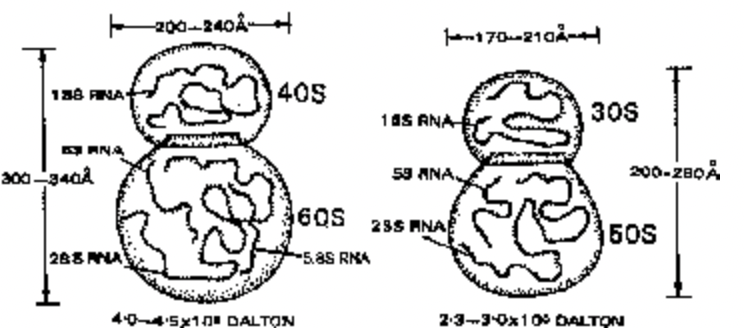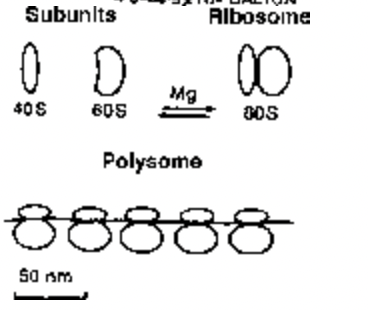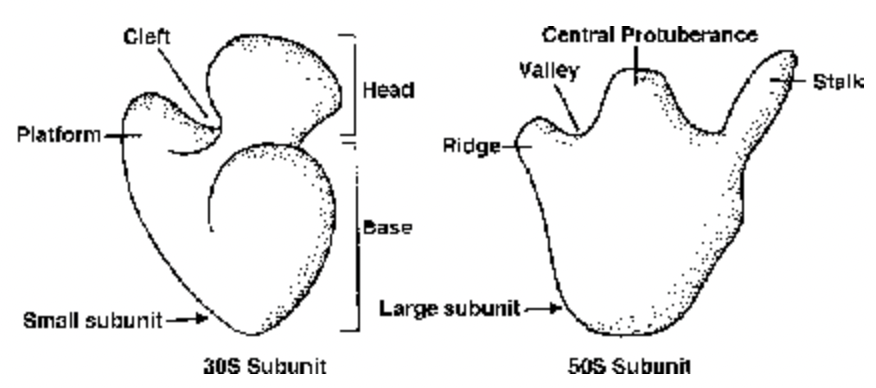Ribosomes/Palade Particles/Protein Factories
Structure of Cell of Class 11
Claude (1941) first observed and called them Microsome.
Robinson and Brown (1953) first observed them in bean roots.
Palade (1955) coined the term ribosome.
Smallest cell organelles (150 × 250 Å) devoid of membrane. Except mammalian RBC, all living cells have ribosomes.
Forms of Ribosomes :
Bound form attached to ER. Protein synthesis for secretion purpose occurs on bound ribosomes.
Free ribosomes - Occur freely suspended in hyaloplasm. Protein synthesis for growth of protoplasm occurs on free ribosomes.
Types of ribosomes :


Fig. 80S and 70S Ribosomes Fig. Subunit structure of the ribosome and the influence of Mg
(1) Eucaryotic ribosomes - 80S = Occur in cytoplasm of eucaryotic cells.
(2) Procaryotic ribosomes - 70S - occur in cytoplasm of procaryotes, and also in mitochondria and chloroplast of eucaryotes.
Each ribosome composed of two subunits i.e. larger and smaller subunits.
80S = 60S + 40S; 70S = 50S + 30S ; S = Svedberg unit or Sedimentation rate = 1 × 10–13 cm/sec./dyne/gm.

Fig. Partss of ribosome
The smaller subunit shows an oblate ellipsoid and cap-like structure, while the larger subunit appears dome-shaped.
The smaller subunit has a platform, a cleft, a head and a base. The larger subunit has a protuberance, a ridge and a stalk.
When associated with ER, they are attached with their 60S subunit.
The ER-bound ribsomes synthesise secretory membrane and lysosomal proteins, whereas the free ribosomes synthesize non-secretory proteins. Some proteins synthesised on ribosomes are transported to such
organelles as nucleus, mitochondria and chloroplasts.
The proper folding of proteins following synthesis is assisted by specific proteins called chaperons, which also assist in transport of proteins into organelles such as mitochondria.
For simultaneous synthesis of variable protein molecules, several ribosomes become attached to m-RNA with the help of smaller subunits. This structure is called polyribosome or polysome or Ergosome. The
ribosomes move along the m-RNA like beads on a string.
Larger subunit contains peptidyl transferase enzyme which catalyses synthesis of peptide bond between aminoacids. Larger subunit has two sites :
(i) A-site or Acceptor site for t-RNA.
(ii) P-site or Site for growing polypeptide chain.
Two subunits are held together by Mg+2 which form ionic bond with phosphate groups of r-RNA of two subunits. Minimum 0.001 M Mg+2 concentration is required for structural formation of ribosomes. If Mg+2
concentration is increased 10 times then ribosome dimer are formed.
80S + 80S = 120S; 70S + 70S = 100S
Chemical composition of ribosomes
70S - 60% r-RNA + 40% proteins
80S - 40% r-RNA + 60% proteins
50S - 34 proteins ; 30S - 21 proteins so total protein molecules in 70S ribosomes are 55.
60S - 45 proteins ; 40S - 33 proteins so total protein molecules in 80S ribosomes are 78.
60S - r-RNA-28S, 5.8S, 5S; 40S - r-RNA-18S
50S - r-RNA-23S, 5S; 30S - r-RNA-16S
Proteins in ribosomes are negatively charged.
Casperson and Schultze (1940); Brown and Gordon (1964) found that r-RNA is synthesized in nucleolus which is termed as Ribosome factory.
- Introduction of Cell
- Concept of Protoplasm
- Theory of Cell
- Cell organization
- Cell Size
- Cellular Totipotency
- Types of Cell
- Flow of Information
- Structure of Cell
- Cell Membrane
- Endoplasmic Reticulam
- Golgi Appratus
- Lysosomes
- Mitochondria
- Plastids
- Nucleus
- Chromosomes
- Ribosomes/Palade Particles/Protein Factories
- Microbodies
- Centrioles
- CILIA AND FLAGELLA
- Cytoskeletal Structures
- Cytoskeletal Structures
- Exercise 1
- Exercise 2
- Exercise 3
- Exercise 4
- Exercise 5
- Exercise 6









